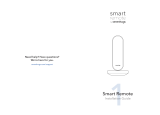
7
Chapter 1
Introduction
1. 1. Product Overview
The AC1900 Wi-Fi Router plus Smart Home Hub plus Touch Screen (also referred to as
Smart Home Router SR20), is an “all-in-one” Wi-Fi router with built-in smart home hub
that eliminates the need for more standalone hubs in your home. It offers a centralized
solution to unify all smart home technologies to seamlessly work together, such as
TP-Link smart home products and other ZigBee and Z-Wave devices. From there, you
can control them by way of the TP-Link Kasa mobile app together with the integrated
4.3-inch touch screen color display atop the router, revolutionizing a new way of
visualizing and interacting with your connected home.
With AC1900-class and 3x3 MIMO technology, the Smart Home Router simultaneously
delivers up to 1300Mbps over 5GHz and 600Mbps over 2.4GHz, offering the flexibility
of two dedicated networks for basic tasks and bandwidth-intensive tasks such as
streaming 4K Ultra HD media and online gaming.
The SR20 features four Gigabit Ethernet ports for lightning-fast data transfer, built-in
NAT-router, Firewall, and Wireless Access Point (AP). The high-gain omni-directional
antenna and powerful amplifiers boosts the Wi-Fi coverage throughout your home.
Coupled with the advanced beamforming technology that allows the SR20 to
concentrate the Wi-Fi signal directly at the connected devices, delivering a stronger
and more reliable Wi-Fi connection.
The Smart Home Router is also a versatile dual-band solution that can function as a
router, or access point to best serve your networking needs, making it an ideal choice
for the Small Office/Home Office (SOHO) networks that demand higher speed and
more reliable network performance. It complies with the next-generation 802.11ac
Wi-Fi standard, and backward compatible with 802.11n, offering 3 times faster than
wireless N speeds. With high power efficiency and robust network security, 802.11ac is
the perfect way to accelerate a home multimedia network and solve traffic congestion
caused by high-bandwidth devices.
Furthermore, the SR20 is equipped with two USB ports (3.0 and 2.0), giving you more
flexibility to share printer(s), files (such as photos, music, and videos) across your home
or office network, locally and remotely via the built-in FTP server.
The SR20 fully supports IPv6, which is the latest version of the Internet protocols that
enables numerous services to interoperate seamlessly and improves user experience.
The product complies with the RSS-247 Section 6.4 (2) and (4).
1. 2. Features
• Simple to set up and use
• Built-in touch screen display for easiest setup and home management






















